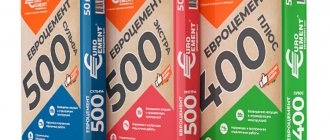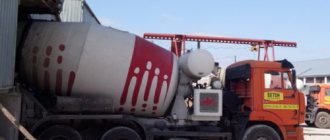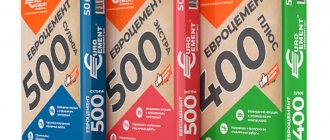Cement is used constantly in construction: they pour foundations or walls, use them for finishing work or to create load-bearing structures. When choosing a brand, you need to pay attention to the environment (temperature, humidity), what pressure the structure will experience, the rate of hardening, etc.
Cement D0 and D20 are often compared, the differences of which are not immediately noticeable. These two types are very different from each other in characteristics - in the second, 20% of the volume is occupied by impurities. But impurities are not always needed.
Source martand.ru
How to decipher the markings
Before finding out how cement D0 and D20 differ, let’s look at the markings. Cement mainly consists of clinker. This is a special mass consisting of high-quality clay and limestone. They are fired at a temperature of 1450 degrees, after which they turn into powder - this is cement. In some cases, gypsum is added, but not more than 1%.
To obtain certain characteristics, special additives are added to cement. They give the mixture additional useful properties; most often, the cement becomes more resistant to low temperatures, moisture and corrosion.
But supplements are not always beneficial. In some works, it is preferable to use “pure” cement, which is more durable and strong; in others (for example, when finishing premises), certain properties of the material are required.
When designating a cement brand, the following designations are used:
- PC is Portland cement;
- Numbers (300, 400, 500) – compressive strength, kg/sq. cm;
- Letters at the end of the number indicate special properties. For example, B is fast-hardening, N is normalized clinker, GF is hydrophobic, PL is plasticizing.
Source avito.st
Example. Cement brand PC400-D20-GF is Portland cement that can withstand weights of up to 400 kg per square meter. cm. It has 20% additives and is hydrophobic (waterproof).
It is worth noting that according to the new GOST, “D0” and “D20” are not used - these designations have been preserved from the previous standard. Instead, indicate the type of additive: slag (S), ash (Z), lime (I).
Cement brand M500 in bags
Cement M 500 is very popular due to the best price-quality ratio. Usually supplied in containers of 50 kilograms, which guarantee ease of loading/unloading, transportation, and calculations.
Portland cement M 500 D0 is produced and packaged using modern equipment, with precise dosage and compliance with GOST. All components undergo quality control and are measured in the required proportions. All parameters comply with GOST 31108-2003, according to which the mixture demonstrates a compressive strength of 19 MPa within 1-2 days after preparing and using the solution.
The packaging contains markings that provide complete information about the cement and include instructions for preparing the mixture. Cement M500 D0 belongs to the class of quick-hardening mixtures with a complete absence of additives. The strength class corresponds to parameter 42.5. The clinker content in the total mass is in the range of 80-95%. When calcined, the weight loss of dry powder does not exceed 1%. The mixture contains about 2.5% sulfur oxide (VI) and 0.02% chloride ions Cl-.
After just 28 days (a full cycle of strengthening the concrete solution), the strength of the monolith is 46 MPa. Concrete sets 45-120 minutes after mixing with water. Final setting occurs 180 hours after mixing. The false setting effect is completely absent.
The specific surface area of M500 cement shows a value of 350 m2/kg, and this is an indicator of excellent grinding quality and the complete absence of various impurities and particles that negatively affect the quality of the mixture itself and the concrete prepared from it.
Eurocement M500 D0, supplied in bags, is a modern building material of excellent quality, which is widely used in repair and construction work. The choice on the market is quite large, so choosing a material that is suitable in terms of characteristics and cost is not difficult.
When choosing, you need to pay attention to the reputation of the manufacturer (it is advisable to trust the best and proven ones) and the date of production of the mixture - the less time has passed since the creation of the cement, the better (the total shelf life is 6 months).
In Moscow and the regions you can find high-quality cement in construction supermarkets and directly from manufacturers.
What do "D0" and "D20" mean?
Now let’s determine what the difference is between cements D0 and D20. In a cement brand, the letter “D” means additives or additives that affect the quality of the substance. The number indicates the percentage of additives to concrete. Thus:
- Cement D0 is “pure” concrete, without any additives;
- D20 cement contains 20% additives.
“Pure” cement is the strongest and most durable. However, it does not tolerate sudden temperature changes and low temperatures; it cannot be used in permafrost conditions. He also does not like strong humidity or the constant presence of water.
Cement with additives has less strength and takes longer to harden. But it has many advantages:
- It has increased resistance to humidity, both permanent and temporary. This may be useful if cement will be used in basements;
Source other-news.ru
- The internal strength is enough to withstand low temperatures or sudden changes. Hardened cement does not crack or deform;
- Resists corrosion well. This is important if reinforced concrete structures are formed or communications will be laid inside the cement.
Characteristic
The product described is a green powder. According to the production technology, first a mixture of limestone and clay is heated and melted in several furnaces at a temperature of +1400°C. The result is cement clinker. At the second stage, it is finely and thoroughly crushed with gypsum.
The finished powder begins to act after a chemical process. A fixed volume of water is added to achieve the desired thickness of the solution. In the end it hardens like a stone. Based on its similarity to local rocks from the port city of Portland, the presented material received its current name.
Its main difference from the others is the presence of a number of useful mineral additives. They influence the strength and active use in any type and specific construction work. Calcium is found in the predominant amount (about 80%), along with aluminum, iron, silicon, potassium and magnesium.
The above manufacturing process gives this product positive characteristics:
- reliable and instant strength;
- resistance to water, moisture and different temperature conditions;
- reliable density and setting after 45 minutes;
- impressive viscosity.
Material with such qualities is used in various construction operations, from the arrangement of the foundation and interior to the façade appearance of the building. It is important to remember the rules for storing it. All active properties of PC500 may deteriorate if handling requirements are not followed.
Portland cement can be stored for 2 months in an airtight container. It is better to keep it in a closed, dry room without moisture penetration, since it has a negative effect on its properties. For example, a basement is absolutely not suitable in this case. If the product is not packaged, it should be placed in a container or barrel and wrapped in polyethylene to prevent lumps and the substance from turning to stone.
It is enough to purchase as much as you need for the current type of work, i.e. before repairs and in moderate quantities. At the same time, you need to avoid the dangerous influence of climate and other factors due to careless storage.
Where is it used?
The difference between D0 and D20 is not only in characteristics - they are used in different jobs. The scope of application of cement is quite extensive. Depending on the type and composition, it is used when pouring foundations, floors, walls and ceilings, in plaster mortar, as plaster and decorative coating, when sealing cracks, etc. The scope of application largely depends on its compressive strength. The higher it is, the more pressure concrete can withstand, the stronger and more reliable it is, the longer its service life.
The following grades of concrete are used:
- M400 D0. It has high frost resistance, but the rate of hardening and deformation during shrinkage are average. Concrete is used in private construction in the construction of prefabricated and monolithic structures, as well as in industrial construction.
Source webflow.com
- M500 D0. It has high frost resistance and strength. Scope of application: large industrial facilities, bridges, airfield runways. It is also used for restoration work.
- M400 D20. It has average performance in all respects: hardening speed, frost resistance and shrinkage deformation. It is used to create structures made of cement.
- M500 D20. It has average frost resistance and hardening. It is used for casting monolithic structures, as well as in individual construction and finishing.
The cost of D0 and D20 cements is different: “clean” concrete is more expensive than the brand.
You can find out how GOST standards have changed and what cement grades are now called in the video
Application
M500 cement is used for the preparation of concrete where it is necessary to provide increased strength along with a high level of resistance to heavy loads. This can include pouring structures/buildings, screeds, as well as emergency repair work.
Where we use cement M500 D0:
- Preparation of reinforced concrete for the construction of walls, panels, floor slabs, armored belts, beams and other structural elements under heavy loads.
- Creation of cement-sand screed.
- Mixing plaster/masonry mortar.
- Pouring a reliable foundation for various types of buildings.
- Various designs operated under conditions of high humidity, high/low temperature.
- Production of reinforced concrete slabs of various types.
- Casting of columns.
- Pouring of supports for power lines.
- Installation of bridges and other hydraulic structures.
- Preparation of various repair mixtures for the implementation of certain tasks.
Briefly about the main thing
Construction cannot be done without cement. The latter is available in various brands: they differ in characteristics and areas of application. At the same time, it is impossible to replace one brand with another: this can even lead to the destruction of the entire building if the chosen brand was not suitable for the situation.
When choosing concrete, I always look at the “D” designation. This letter indicates the percentage of additives contained in the material. Most often I need cement with certain properties, and I choose “D20”, but a couple of times I needed “pure” powder. Then I took bags of D0 concrete.
Question
Write in the comments if you use cement in your work? Which type are you using: for the foundation, walls or finishing?











